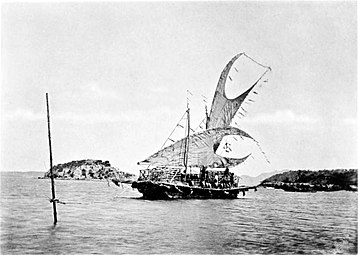
Lakatoi (also Lagatoi) are multiple-hulled sailing watercraft of Papua New Guinea. They are named in the Motu language and traditionally used in the Hiri trade cycle.
Lakatoi (whose literal meaning is three dugouts) are fashioned from two or more dugout logs fastened together to give stability and cargo-carrying capacity. The two or more dugouts are joined by booms, with a platform built on top. The sail is a crab-claw sail. Horridge (2008) discusses the rig and how the craft is manouvred.
Gallery
-
 Loading a lakatoi at Port Moresby, prior to 1885
Loading a lakatoi at Port Moresby, prior to 1885
-
 Lakatoi near Elevala Island, prior to 1885
Lakatoi near Elevala Island, prior to 1885
-
 Papuan lake dwellings with a lakatoi under sail, 1898 or before
Papuan lake dwellings with a lakatoi under sail, 1898 or before
-
 1901 stamp by the British Government depicting a lakatoi
1901 stamp by the British Government depicting a lakatoi
See also
References
- ^ Mahdi, W. (1999). "The dispersal of Austronesian boat forms in the Indian Ocean" (PDF). Archaeology & language III, Artefacts, languages and texts: 144–208. Archived (PDF) from the original on 2024-03-17. Retrieved 2024-03-17.
- "Journal of the Polynesian Society: Front Matter P 1-6". Jps.auckland.ac.nz. Retrieved 2016-01-19.
- "Motuan traders go west in their Lakatoi". II(8) Pacific Islands Monthly. 11 March 1932. Archived from the original on 26 September 2021. Retrieved 26 September 2021.
- Pawley, A., & Pawley, M. (1998). "Canoes and seafaring" (PDF). The Lexicon of Proto Oceanic: The Culture and environment of ancestral Oceanic society 1: Material Culture. Pacific Linguistics. Archived (PDF) from the original on 2024-03-17. Retrieved 2024-03-17.
{{cite journal}}: CS1 maint: multiple names: authors list (link) - "Motuan Traders Abandon Ancient Lakatoi Custom". Pacific Islands Monthly. 1935-02-21. Archived from the original on 2024-03-17. Retrieved 2024-03-18.
- Horridge, A (2008). "Origins and Relationships of Pacific Canoes and Rigs" (PDF). Canoes of Oceania. V: 85–105. Archived (PDF) from the original on 2024-03-17. Retrieved 2024-03-17.
| Types of sailing vessels and rigs | |||||||||||||||||
|---|---|---|---|---|---|---|---|---|---|---|---|---|---|---|---|---|---|
| Overviews | |||||||||||||||||
| Sailing rigs | |||||||||||||||||
| By sailing rigs | |||||||||||||||||
| Multihull vessels | |||||||||||||||||
| Naval and merchant sailing ships and other vessels (by origin date) |
| ||||||||||||||||
| Fishing vessels | |||||||||||||||||
| Recreational vessels | |||||||||||||||||
| Special terms | |||||||||||||||||
| Other types | |||||||||||||||||
| Related | |||||||||||||||||
This sailing-related article is a stub. You can help Misplaced Pages by expanding it. |




